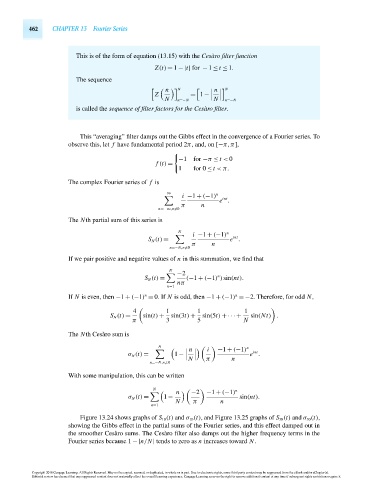Page 482 - Advanced engineering mathematics
P. 482
462 CHAPTER 13 Fourier Series
This is of the form of equation (13.15) with the Cesàro filter function
Z(t) = 1 −|t| for − 1 ≤ t ≤ 1.
The sequence
n
N N
Z n
N n=−N = 1 − N n=−N
is called the sequence of filter factors for the Cesàro filter.
This “averaging” filter damps out the Gibbs effect in the convergence of a Fourier series. To
observe this, let f have fundamental period 2π, and, on [−π,π],
−1 for −π ≤ t < 0
f (t) =
1 for 0 ≤ t <π.
The complex Fourier series of f is
∞ n
i −1 + (−1)
int
e .
π n
n=−∞,n =0
The Nth partial sum of this series is
N n
i −1 + (−1)
int
S N (t) = e .
π n
n=−N,n =0
If we pair positive and negative values of n in this summation, we find that
N
−2
n
S N (t) = (−1 + (−1) )sin(nt).
nπ
n=1
n
n
If N is even, then −1 + (−1) = 0. If N is odd, then −1 + (−1) =−2. Therefore, for odd N,
4 1 1 1
S N (t) = sin(t) + sin(3t) + sin(5t) + ··· + sin(Nt) .
π 3 5 N
The Nth Cesàro sum is
N
n
i −1 + (−1)
n int
σ N (t) = 1 − e .
N π n
n=−N,n =0
With some manipulation, this can be written
N
n −2 −1 + (−1) n
σ N (t) = 1 − sin(nt).
N π n
n=1
Figure 13.24 shows graphs of S 10 (t) and σ 10 (t), and Figure 13.25 graphs of S 30 (t) and σ 30 (t),
showing the Gibbs effect in the partial sums of the Fourier series, and this effect damped out in
the smoother Cesàro sums. The Cesàro filter also damps out the higher frequency terms in the
Fourier series because 1 −|n/N| tends to zero as n increases toward N.
Copyright 2010 Cengage Learning. All Rights Reserved. May not be copied, scanned, or duplicated, in whole or in part. Due to electronic rights, some third party content may be suppressed from the eBook and/or eChapter(s).
Editorial review has deemed that any suppressed content does not materially affect the overall learning experience. Cengage Learning reserves the right to remove additional content at any time if subsequent rights restrictions require it.
October 14, 2010 14:57 THM/NEIL Page-462 27410_13_ch13_p425-464

